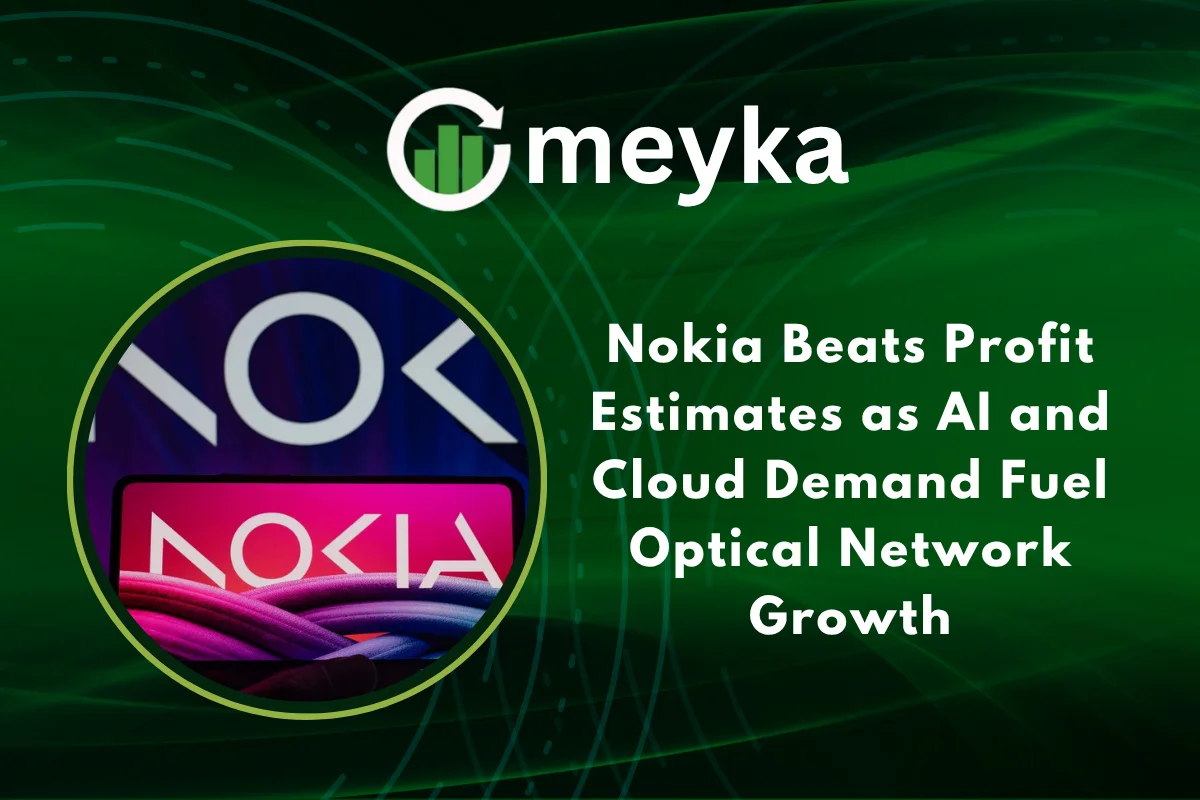Nokia Beats Profit Estimates as AI and Cloud Demand Fuel Optical Network Growth
Nokia has surprised the market once again. The Finnish tech giant beat profit estimates as booming demand for AI and cloud infrastructure lifted its optical network sales to new highs. Riding the wave of next-generation data-centre expansion, Nokia’s latest results show a company reinventing itself for the AI era, proving that innovation, not nostalgia, is driving its comeback.
Strong Q3 Results from Nokia: A Turning Point
Nokia’s most recent quarter delivered a meaningful upside surprise. The company reported a comparable operating profit of €435 million, significantly above analyst expectations of around €342 million. Net sales rose by 12% year-on-year to €4.83 billion, again exceeding forecasts.
Crucially, growth was not uniform across all divisions. The optical-network business, a key part of the network infrastructure segment, saw a 19% increase on a constant-currency basis. (Meanwhile, Nokia disclosed that AI & cloud customers accounted for 6% of group net sales and 14% of network infrastructure sales, showing how the company is capitalizing on the infrastructure build-out for data centres and AI workloads.
As part of its outlook, Nokia slightly revised its full-year comparable operating profit guidance to €1.7 billion-€2.2 billion, signalling management’s confidence in the underlying demand environment.
Why the Growth? The AI & Cloud Infrastructure Boom
The growth driver behind Nokia’s turnaround is clear: major investments in AI and cloud infrastructure are forcing a surge in demand for high-capacity optical and data-centre networks. As the company’s new CEO, Justin Hotard, stated, we are in the “front end of an AI super-cycle, much like the internet of the 1990s.”
Specifically:
- The optical-networks business is benefiting from hyperscale data centres, AI model training clusters, and cloud providers needing massively higher bandwidth.
- Nokia’s acquisition of Infinera further strengthens its position in high-performance fibre optics and intra-data-centre interconnects.
- With mobile-network growth moderating globally, Nokia is shifting emphasis toward network infrastructure and cloud-oriented products.
In short, the company is positioned at the intersection of core trends in AI stocks and network infrastructure investment.
Breaking Down Nokia’s Business Units
1. Network Infrastructure
This segment showed the most robust growth. Revenue climbed approximately 11% year-on-year to around €1.95 billion. Optical Networks within this segment rose by ~19%. The book-to-bill ratio in the optical and IP networks business remained above one, signalling incoming orders exceed shipments, a positive forward indicator.
2. Cloud & Network Services
Here, Nokia reported an ~8–13% increase in sales (depending on which source is used) for cloud- and core-network services, reaching about €645 million. The margin improvement in this segment supports Nokia’s shift toward higher-value services rather than purely hardware.
3. Mobile Networks
This remains a large part of Nokia’s business, but growth is tepid: approximately 4% increase in revenues to €1.84 billion in the quarter. The mobile-networks segment is facing headwinds from slower 5G roll-outs in some geographies and tougher competition.
4. Nokia Technologies (Licensing)
The patent-licensing and technology-licensing unit posted strong growth: up ~11%-14% to about €391 million. With operating margins in this business exceeding others, it’s a favourable contributor.
Implications for Stock Research & Stock Market Investors
For investors analyzing Nokia as part of the broader AI stocks universe, several factors stand out:
- Growth pivot. Nokia is shifting from a mobile-network business toward being a key enabler of AI/cloud infrastructure. This strategic repositioning can improve its investment appeal.
- Order backlog & margin potential. With optical-network orders strong and book-to-bill above one, the pipeline looks promising. Margins, however, face pressure from product mix and currency headwinds.
- Valuation context. Nokia’s shares surged ~11% on the results announcement. Investors should compare Nokia’s valuation versus peers and assess whether the growth fundamentals support current levels.
- Risks. These include currency fluctuations (especially euro vs USD), aggressive competition in telecom infrastructure (e.g., Ericsson, Huawei), macro-economic slowdowns impacting operator capex, and execution risk in the AI/cloud strategy.
From a market-wide perspective, the momentum behind AI-driven infrastructure investment is real. Companies like Nokia that occupy mid-stream positions (optical networks, data-centre interconnects, cloud service enablement) may offer differentiated exposure compared to the headline AI software names.
What to Monitor Going Forward
If we are tracking Nokia’s performance and assessing its role within the stock market ecosystem, we recommend focusing on:
- Order book success in optical-network and cloud-core segments: an increase in bookings signals future revenue sustainability.
- Margin trends: whether Nokia can translate top-line growth into operating profit improvement and control costs.
- Geographic mix: growth in North America, India, and Asia-Pacific will be key, as mobile-network saturation increases in developed markets. (
- Competitive wins: contract announcements with major cloud/data-centre operators or telecom carriers would validate strategic momentum.
- Guidance updates: Any upward revision of full-year profit or cash-flow targets would enhance investor confidence.
Conclusion: Nokia’s Reinvention in Motion
In conclusion, Nokia is delivering on the promise of a strategic transformation. Leveraging the boom in AI and cloud-infrastructure investments, it has delivered a profit beat, accelerated growth in its optical and network-infrastructure units, and raised its guidance. For investors seeking exposure to companies benefiting from the AI/data-centre build-out, Nokia represents a compelling case, albeit not without risks.
As we continue our stock research in the stock market ecosystem, Nokia warrants consideration as part of the broader set of AI stocks, especially those involved in infrastructure rather than application-layer hype. Its performance suggests the company is adapting well to new secular trends, positioning itself for the next chapter of technological growth.
FAQs
The growth was driven primarily by increased demand from AI and cloud customers who require high-capacity fibre and interconnect solutions. Nokia reported that AI/cloud customers accounted for ~6% of group net sales and ~14% of its network infrastructure segment.
While many AI stocks are software firms or chip suppliers, Nokia is an infrastructure-enabler, building the networks and data-centre interconnects underpinning AI. Thus, its performance is less about algorithmic innovation and more about telecom & optical hardware demand, which may offer differentiated exposure in the AI theme.
The principal risks include currency headwinds (euro strengthening vs USD), slowing telecom operator spending, intense competition in network infrastructure, execution delays in the AI/cloud pivot, and margin pressure due to product-mix shifts. Investors should also watch how Nokia manages operating margin improvements as it scales.
Disclaimer:
The content shared by Meyka AI PTY LTD is solely for research and informational purposes. Meyka is not a financial advisory service, and the information provided should not be considered investment or trading advice.






